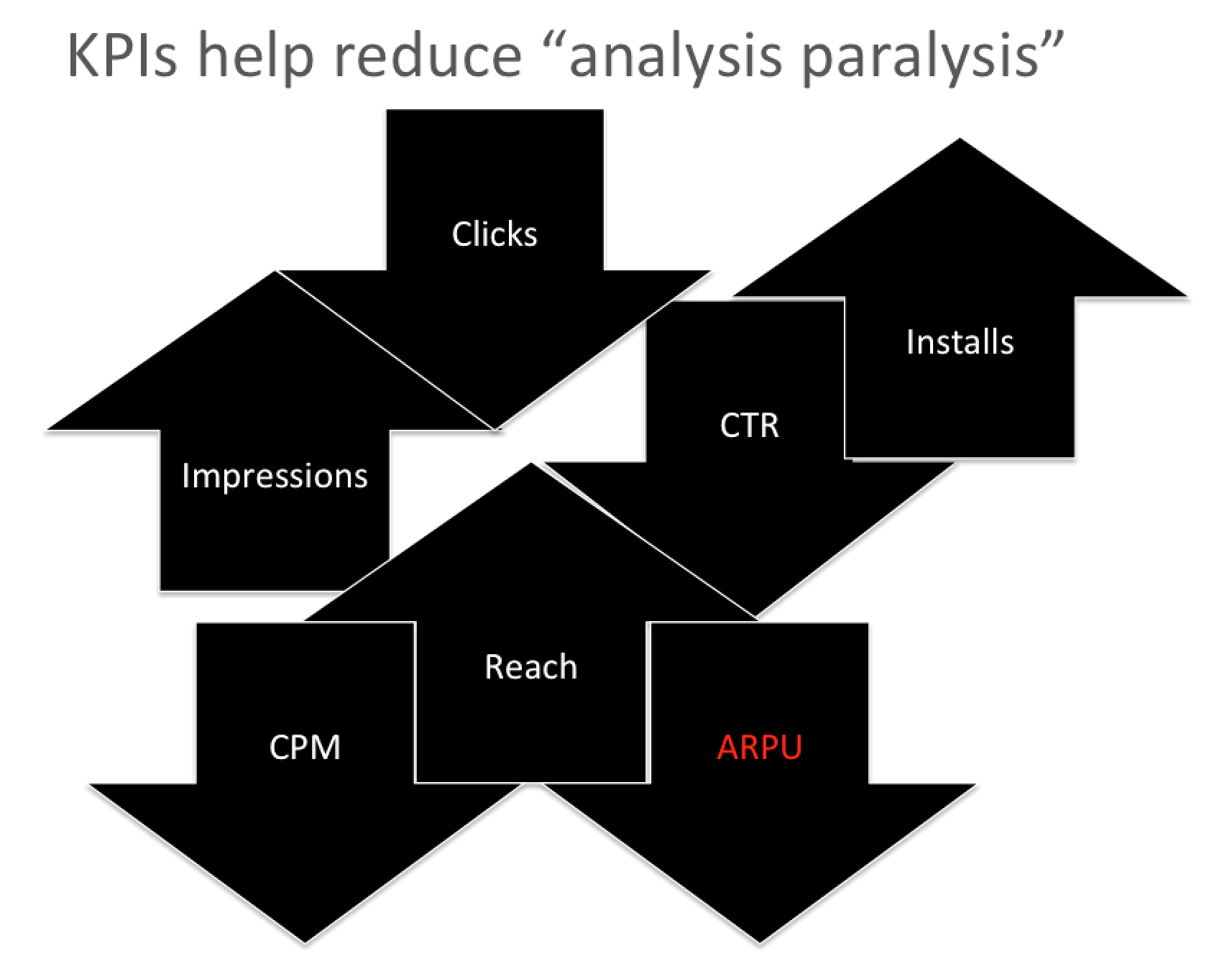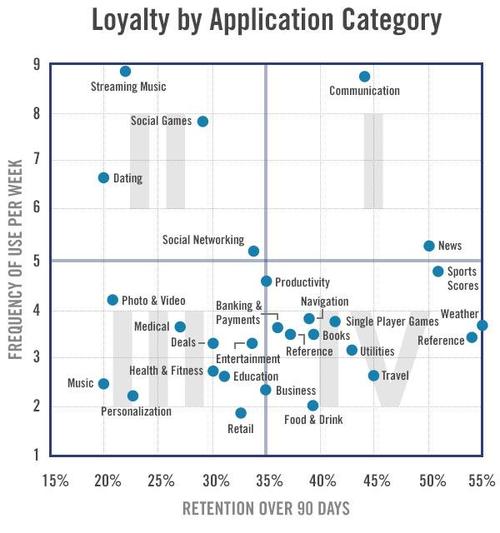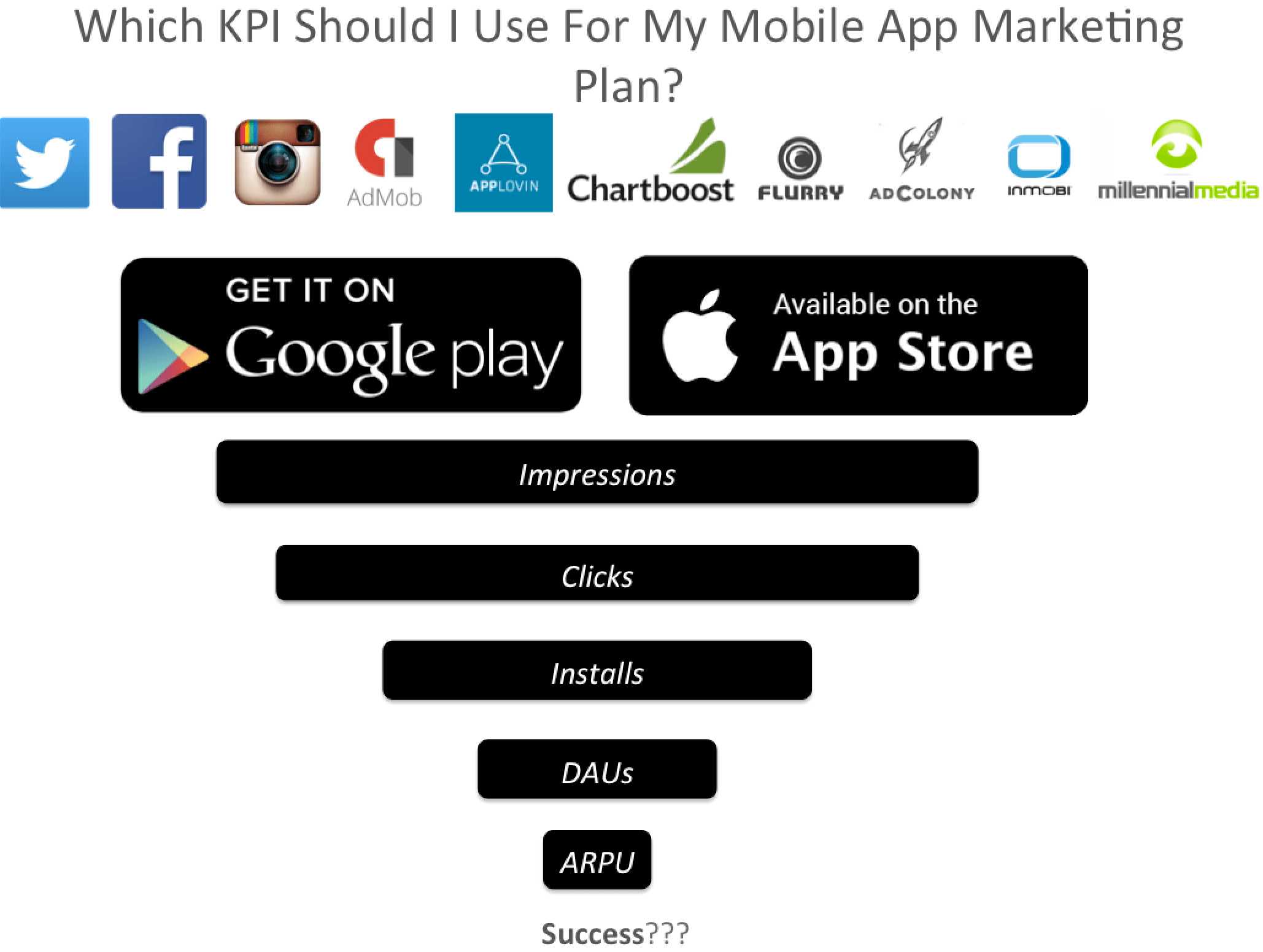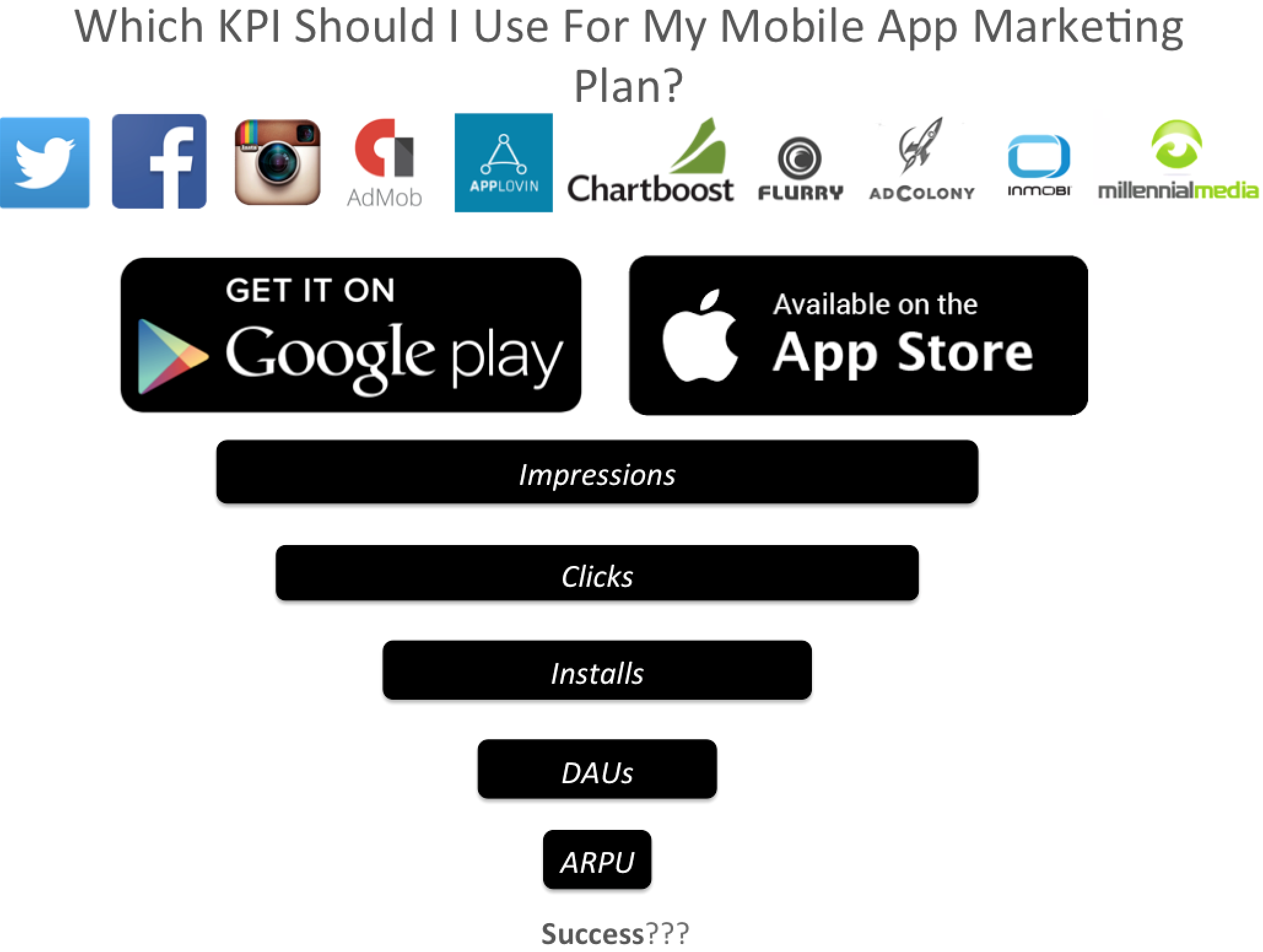Incipia blog
How to Choose the Best Mobile App KPI
Which metrics are the best to use for my app marketing strategy?
The short answer is that it depends, but the good news is that the process of selecting the right metric for your app marketing strategy is pretty straightforward. Read on to learn about:
- The difference between metrics and KPIs
- Choosing the right KPI for your app
- Choosing the right KPI for your app marketing strategy
Metrics vs KPIs
Metrics are performance indicators, or data points that you use to figure out what’s going on across each of your channels and segments. Just like squares and rectangles, every KPI is a special kind of metric; however not every metric is a KPI. Here are some examples of regular metrics for app marketing strategies:
- Impressions (a count of each time your ad or post is shown)
- Reach (a count of the unique number of people who see your ad or post)
- Clicks
- Quality or Relevance Score (an aggregated measure of an ad’s relevance to the users it is shown to, established by platforms like Facebook, Adwords or Bing Ads. These scores are based on an advertiser’s content and ad user engagement; FYI these scores can impact your ad reach and also how much you pay to show ads)
- CPM (cost per thousand ad impressions)
- CTR (click through rate)
- Cost
- CPC (cost per click)
- Average Screens Per Session (can sometimes be a KPI if tied to revenue)
- Average Sessions Per User (can sometimes be a KPI if tied to revenue)
KPI stands for key performance indicator, and is a recognition reserved only for the particular metric(s) that is/are most important to your mobile app marketing plan, depending on your situation and goals. The purpose of a KPI is to help you be decisive and prevent analysis paralysis, which is vital to avoid when marketing apps and can happen when you have multiple metrics telling you different things. Here are some examples of KPIs for app marketing strategies:
- New User Referral rate How many new users does each of your acquired users refer?
- ARPU (average revenue per user, which can take into account revenue attributed to ads, in app purchases, paid downloads, subscriptions and any other applicable source)
- LTV (lifetime value of a user/customer, which takes ARPU one step further into considering things like churn rate, referrals and repeat purchases)
- DAU/MAU (the average number of daily or monthly active app users)
- CAC (customer acquisition cost - how much you pay to acquire each new customer/user)
- Churn rate (a measure of how many users stop using your app after a period of time - there are many ways to calculate churn rate, depending on how complex or accurate you want to get)
- NPS (net promoter score - a ratio of your user advocates:neutral users:detractors. NPS is a difficult KPI to measure that requires actually talking to users rather than just measuring app usage. GrowthBug published a great article on measuring NPS from app users)
- Free-to-paid conversion rate (users who pay for a service / all users)

Metrics, like cost or clicks are useful to sort your mobile app marketing campaigns, segments and channels by highest to lowest, to identify those that have the largest impact on your overall mobile app marketing plan, and then use KPIs to dive deeper and determine which entities perform best and worst. For example, sort by campaign cost to see which campaigns use the largest portion of your budget, and then determine whether the campaigns with the highest impact on budget have the best performance by that KPI. If not, it may be time to reallocate budget to better performing campaigns, or work to optimize that high impact, underperforming campaign to improve its KPI.

When selecting your app marketing KPIs, keep these two questions in mind:
- What type of app am I marketing?
- Which stage in the user lifecycle is most important to my mobile app marketing plan right now?
What type of app are you marketing?
Both your KPIs and what constitutes poor/average/good performance will greatly depend on the type of app you’re marketing. For games where ARPU is naturally very low per individual user yet there may be many active users, a good KPI may be focused on keeping users engaging as long as possible (i.e. maintaining high DAUs). For a SaaS app where most users are free(loader)mium users, the best KPI is most likely focused on how well you can convince free users to become paid users (i.e. maximizing the freemium:paid conversion rate).
Consider this study of user engagement by Flurry, where we can see how much engagement rates fluctuate by app category in this chart.

Here are some suggestions of KPIs for common app categories:
- All apps: CAC, ARPU/LTV, Churn rate/DAU/MAU, new user referral rate
- Games: Avg session length, avg content unlocks per user, avg app launches/user, ARPU
- Social: Avg session length, avg content shares/user, avg connections/user, ARPU
- SaaS: free:paid conversion rate, avg time to close support issues, LTV
- E-Commerce: LTV, avg transactions/user, avg order value
Your app’s monetization strategy will also affect what type of KPI you select:
- For apps offering in app purchases, you’ll want to look mostly at ARPU from purchases and churn rates, studying what price points maximize your revenue and what bottlenecks cause your users to stop using your app or not purchase. And referrals.
- For ad-monetized apps, a chief concern is maximizing DAUs and reducing churn rate, followed by minimizing your CAC for engaged new users. And referrals.
- For apps that are paid download, you’ll want to work hard to keep your CAC below the revenue you make per download. And naturally, referrals.
KPI expectations can also fluctuate across a host of dimensions beyond app category or monetization strategy, including but not limited to:
- App platform (e.g. Apple vs Android)
- Country (e.g. US vs Denmark vs India vs Ghana vs Brazil)
- Acquisition source (e.g. Facebook vs Twitter or incentivized vs non-incentivized)
Which stage in the user lifecycle is most important to your strategy right now?
The user lifecycle can be simplified down into a model called AARRR, which is an excellent marketing concept introduced in 2007 by renown growth hacker:Dave McClure.
AARRR stands for:
- Acquisition (getting users to install your app)
- Activation (getting users to actually sign up if necessary and use your app)
- Retention (getting users to use your app for as long as possible)
- Referral (getting users to tell people in their networks to use your app)
- Revenue (maximizing the money you make in aggregate from each app user)
Because the goal in each stage is different and can conflict with one another (e.g. total installs for acquisition vs activation/retention, AKA the right installs), each stage therefore has a unique KPI to measure the performance of your mobile app marketing plan.
Stay tuned for an upcoming post, where I will break down the AARRR concept in greater depth.
Wow! That’s a lot of data. How do I keep track of it all?
In order to get access to your KPIs, you’ll need to set up platforms that can track how people download your app (attribution), and also integrate technologies through SDKs (Software Development Kits) into your app code to see what users do after they install it (analytics). Here are some technologies that can help you track your app attribution and analytics:
- Adjust (analytics + attribution focus) - an app platform led by a capable tech team out of Germany with good industry credibility.
- Localytics (attribution + analytics focus) - a solution built for both websites and apps, free under 10,000 MAUs.
- Appsflyer (attribution focus) - an app platform with a wide reach of marketing data partners (a must for attribution platforms) and a fee based on the number of weekly non-organic installs.
- Branch Metrics (attribution focus) - a free app deep linking platform providing deep link analysis and intelligence.
- Mixpanel (analytics focus) - a solution built for both websites and apps, well-known for its ability to profile users based on actions taken; free <25,000 data points and <1,000 user profiles.
That’s all for today! Thank you for following along. Sign up for our email list below for more posts on app marketing strategies, tips and tricks on marketing apps and other useful topics in the world of apps, and please feel free to email in to request future blog topics.
At Incipia we develop and market mobile apps and are available for hire as a full service app firm. For inquiries, contact us
Be sure to check out our latest posts on app marketing for more tips, tricks & best practices.
Check out our new infographic on Metrics vs KPIs; you can download it here:

Categories
Tags:
- A/B testing
- adjust
- advertising
- adwords
- agile
- analytics
- android development
- app analytics
- app annie
- app development
- app marketing
- app promotion
- app review
- app store
- app store algorithm update
- app store optimization
- app store search ads
- appboy
- apple
- apple search ads
- appsee
- appsflyer
- apptamin
- apptweak
- aso
- aso tools
- attribution
- client management
- coming soon
- design
- development
- facebook ads
- firebase
- google play
- google play algorithm update
- google play aso
- google play console
- google play optimization
- google play store
- google play store aso
- google play store optimization
- google uac
- google universal campaigns
- idfa
- ios
- ios 11
- ios 11 aso
- ios 14
- ios development
- iot
- itunes connect
- limit ad tracking
- ltv
- mobiel marketing
- mobile action
- mobile analytics
- mobile marketing
- monetization
- mvp
- play store
- promoted iap
- promoted in app purchases
- push notifications
- SDKs
- search ads
- SEO
- skadnetwork
- splitmetrics
- startups
- swift
- tiktok
- uac
- universal app campaigns
- universal campaigns
- user retention
- ux
- ux design

